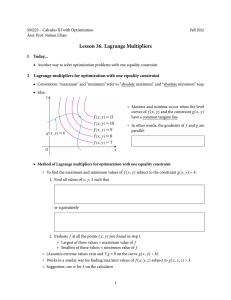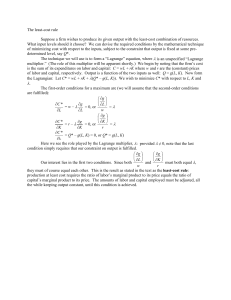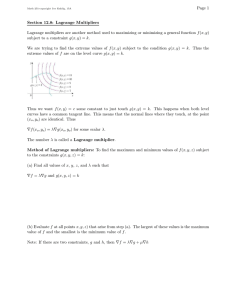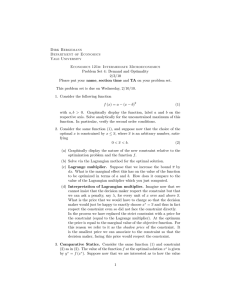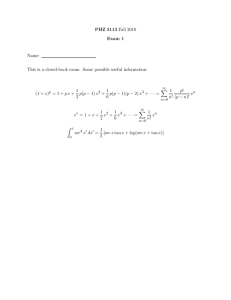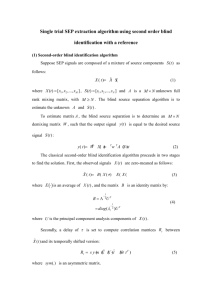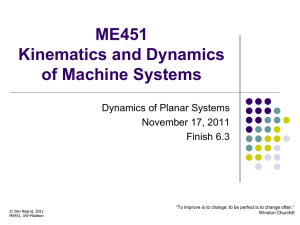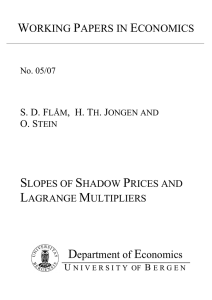ME 447 : Computer Aided Design
advertisement
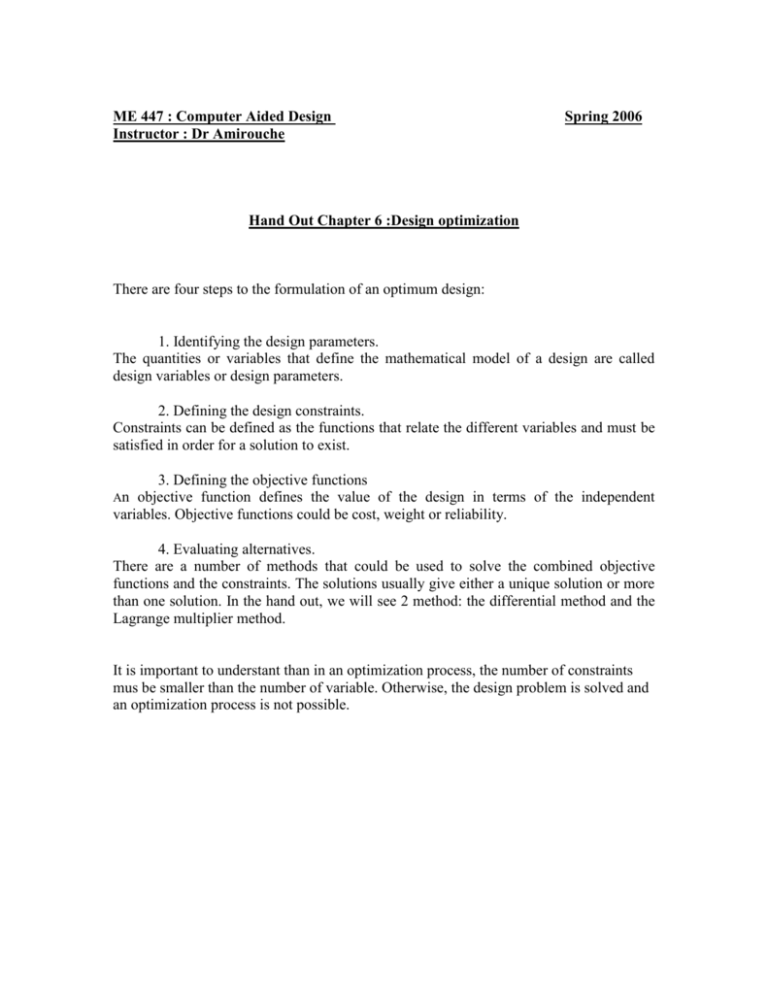
ME 447 : Computer Aided Design Instructor : Dr Amirouche Spring 2006 Hand Out Chapter 6 :Design optimization There are four steps to the formulation of an optimum design: 1. Identifying the design parameters. The quantities or variables that define the mathematical model of a design are called design variables or design parameters. 2. Defining the design constraints. Constraints can be defined as the functions that relate the different variables and must be satisfied in order for a solution to exist. 3. Defining the objective functions An objective function defines the value of the design in terms of the independent variables. Objective functions could be cost, weight or reliability. 4. Evaluating alternatives. There are a number of methods that could be used to solve the combined objective functions and the constraints. The solutions usually give either a unique solution or more than one solution. In the hand out, we will see 2 method: the differential method and the Lagrange multiplier method. It is important to understant than in an optimization process, the number of constraints mus be smaller than the number of variable. Otherwise, the design problem is solved and an optimization process is not possible. Problem 6.1 Find the dimensions of an oil storage tank resulting in a minimum cost using optimal conditions Given data: a) Cost of the two lids = 10.00 per m2. b) Lifelong maintenance cost of surface = 80 per m2. c) Main body tank surface cost =8.00 per m2. d) Overall volume is fixed at 60 m3. 1. Identifying the design parameters The design parameters are: the diameter of the cylinder: x 2r the height of the cylinder: L 2. Select an objective function Here we are trying to minimize the cost of the tank. Therefore, the objective function of the problem should be the cost. x 2 2 m (There are two lids).The surface area of the main The area of the lid is given by 4 body tank surface is given by xL m2. The surface area of the total surface is given by 2x 2 xL m2 where x=2r where r is the radius 4 We define the objective function: x 2 2x 2 *10 xL * 8 f 2 * xL * 80 4 4 2 2 f 5x 8xL 40x 80xL Or f 45x 2 88xL 3. Determine a set of constraints The only constraint in this problem is the volume of the tank. It is fixed. The volume is defined by x 2 4 * L 60 4. Optimization method Differential method If you have a constraint defined, substitute the constraint in the objective function in order to reduce the number of unknown. In our case, using the constraint, we can deduce an expression for L 240 L 2 x and substituting L in the objective function we get, 240 f 45x 2 88x 2 x which can be simplified further as f 45x 2 21120 x In a differential method, to minimize f , we evaluate f x = 0 21120 f x 90x 0 x2 90x 3 21120 x 3 74.697 x 4.21m and the radius is x/2= 2.105 m. hence, L 240 240 4.31 m. 2 x ( 4.21) 2 Lagrange Multiplier In the Lagrange multiplier method, the function to be optimized is defined by augmenting the objective function by the constraints pre-multiplied by a variable called the Lagrange multiplier. This is given by m T To j j j 1 where To is the objective function, the undetermined multipliers and the constraints. The optimum is obtained by differentiating with respect to the independent variables and the undetermined multipliers and setting the derivatives to zero. T 0 j T 0 xi (i 1, n; and j 1, m) In our case, the constraint function can be expressed as x, L x 2 L 60 0 . The 4 objective function is the same as used in the differential method. Hence the function to be optimized which include the undetermined multipliers and the constraints becomes x 2 F * 45x 2 88xL L 120 4 * Taking the partial derivatives of F with respect to x, L and and setting them equal to zero will yield 3 equations and 3 unknowns. Solution of which gives the optimum values of x, L , and of course F * . The partial derivatives of F * with respect to x, L and are F * x 90x 88L L 0 (1) x 2 F * x 2 88x 0 L 4 F * x 2 L 60 0 4 (2) gives a direct relationship between x and λ (2) (3) 352 x (3) gives reduces to : L 240 x 2 Substituting L and λ into the first equation, we can solve directly for x x 4.31m

